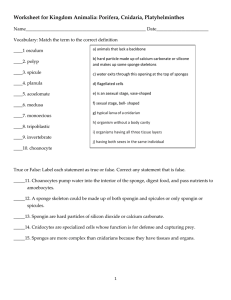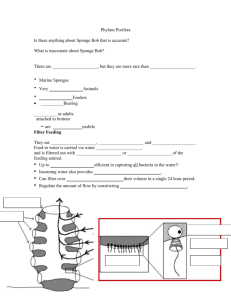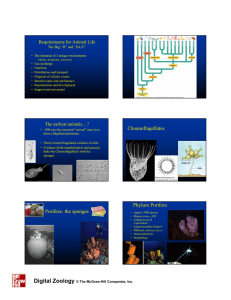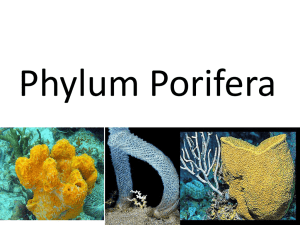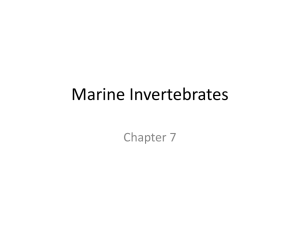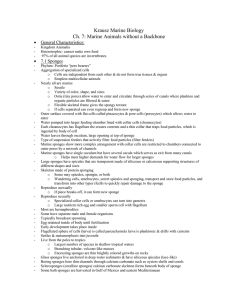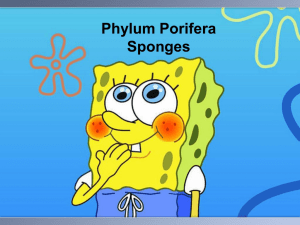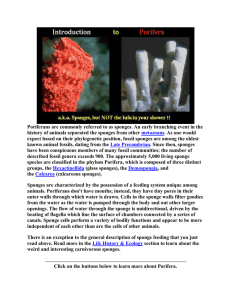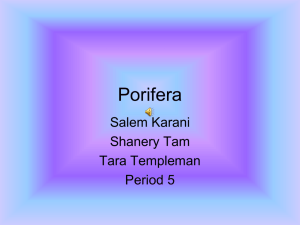Phylum Porifera - McCarthy's Cool Science
advertisement
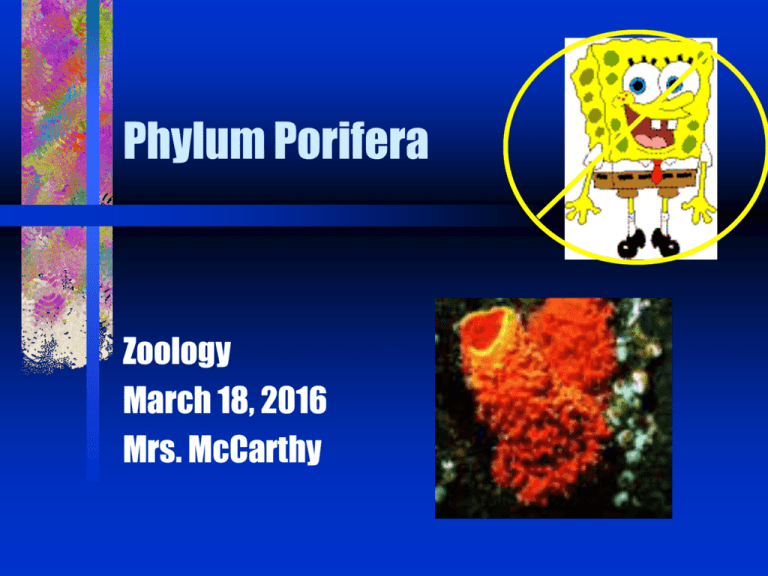
Phylum Porifera Zoology March 18, 2016 Mrs. McCarthy I. A. B. C. D. E. Basic Characteristics Porifera means “pore bearing” 5,000 species, mostly marine No organs or true tissues Mostly asymmetrical Adults are sessile (attached) Sponge videoclip F. Nutrition from filter feeding 1. Ostia – tiny pores for INCOMING water 2. Osculum – big opening to RELEASE water 3. All are connected by canals 4. Spongocoel – inner, hollow cavity 5. Choanocytes – collar cells with flagella that sweep water into pores and trap food Sponge Structure Water Flows out Water flows in through osculum Choanocyte through Flagellum porocyte Spicule Spongocoel Epidermis Archaeocyte Mesohyl H. Support System 1. Spicules – calcium or silicon “needles” for support 2. Spongin – soft protein 3. Mesoglea - jelly like middle layer a. choanocytes- collar cells b. amebocytes – move around and digest food c. d. sclerocytes – make spicules spongocytes – make spongin e. Myocytes – open and close the ostia (pore cells) II. Feeding A. Filter Feeders 1. rely on water currents to bring food B. Feed on bacteria, plankton, protists and other suspended organic material C. Some sponges are carnivorous 1. feed on some small crustaceans D. Also absorb dissolved nutrients III. Reproduction A. Asexual 1. budding 2. regeneration 3. gemmules – internal buds that remain dormant until the parent dies B. 1. 2. Sexual monoecious fertilization produces a ciliated larva IV. Body Shapes A. Asconoid – simple, tube shaped B. Syconoid – tubular body, thick walls 1. some connecting canals C. 1. Leuconoid – Most complex and common contains large, complex chambers V. Classes of Sponges A. Class Calcarea 1. Spicules of calcium 2. Small, vase shaped 3. Leucosolenia 4. Sycon B. Class Hexactinellida 1. Glass sponges 2. Silicon spicules 3. Radially symmetrical 4. Deep sea bottom 5. Euplectella – Venus’ flower basket c. Class Demospongiae 1. 95% of all sponges 2. Silicon spicules & spongin 3. Spongia – bath sponge d. Class Sclerospongiae 1. Looks like coral, calcareous skeleton VI. Ecological and Economic Benefits A. Large populations of sponges reduce turbidity in coastal waters 1. a single sponge (1cm in diameter and 10 cm in height) can filter 20 liters of water per day !! B. Commercial and bath sponges used for cleaning, painting Classification Kingdom Animalia Phylum Porifera Class Calcarea Genus Leucosolenia Genus Sycon Class Hexatinellida Genus Euplectella (Venus’ flowerbasket) Class Demospongiae Genus Spongia (bath sponge) Class Sclerospongiae A. If you were a planktonic organism, why would you NOT want to go to this restaurant? B. Explain what the parts represent in the real sponge.
